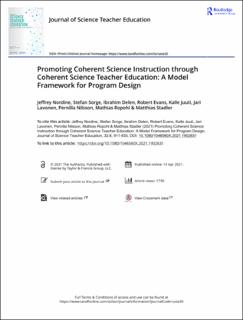| dc.contributor.author | Nordine, Jeffrey | |
| dc.contributor.author | Sorge, Stefan | |
| dc.contributor.author | Delen, Ibrahim | |
| dc.contributor.author | Evans, Robert | |
| dc.contributor.author | juuti, kalle | |
| dc.contributor.author | Lavonen, Jari | |
| dc.contributor.author | Nilsson, Pernilla | |
| dc.contributor.author | Ropohl, Mathias | |
| dc.contributor.author | Stadler, Matthias Gregor | |
| dc.date.accessioned | 2022-02-08T13:48:23Z | |
| dc.date.available | 2022-02-08T13:48:23Z | |
| dc.date.created | 2021-08-18T16:22:17Z | |
| dc.date.issued | 2021 | |
| dc.identifier.issn | 1046-560X | |
| dc.identifier.uri | https://hdl.handle.net/11250/2977744 | |
| dc.description.abstract | Recent research and reform efforts in science education have consistently stressed the importance of coherent science instruction, in which learning opportunities are connected and contextualized by meaningful phenomena, focus on a small set of core ideas over time, and generate a need-to-know about new ideas through a set of connected lessons. Yet, this type of instruction remains uncommon in schools. We argue that science teacher education has the potential to play a powerful role in promoting coherent science instruction in schools, but to reach this potential, science teacher education programs themselves must be coherent. Based on existing literature and our work in an international collaboration focused on effective practices in science teacher education, we identify key features of coherent science teacher education programs and present a new model that we refer to as the Science Teacher Education Programmatic Coherence (STEP-C) model. The STEP-C model illustrates how key elements of science teacher education are situated relative to each other, potentially serving as a powerful tool for program design. | en_US |
| dc.language.iso | eng | en_US |
| dc.publisher | Routledge | en_US |
| dc.rights | Navngivelse 4.0 Internasjonal | * |
| dc.rights.uri | http://creativecommons.org/licenses/by/4.0/deed.no | * |
| dc.title | Promoting Coherent Science Instruction through Coherent Science Teacher Education: A Model Framework for Program Design | en_US |
| dc.type | Journal article | en_US |
| dc.type | Peer reviewed | en_US |
| dc.description.version | publishedVersion | en_US |
| dc.rights.holder | Copyright 2021 The Author(s) | en_US |
| cristin.ispublished | true | |
| cristin.fulltext | original | |
| cristin.qualitycode | 1 | |
| dc.identifier.doi | 10.1080/1046560X.2021.1902631 | |
| dc.identifier.cristin | 1944926 | |
| dc.source.journal | Journal of Science Teacher Education | en_US |
| dc.source.pagenumber | 911-933 | en_US |
| dc.relation.project | EU/2017-1-DE03-KA201-035669 | en_US |
| dc.identifier.citation | Journal of Science Teacher Education. 2021, 32 (8), 911-933. | en_US |
| dc.source.volume | 32 | en_US |
| dc.source.issue | 8 | en_US |

